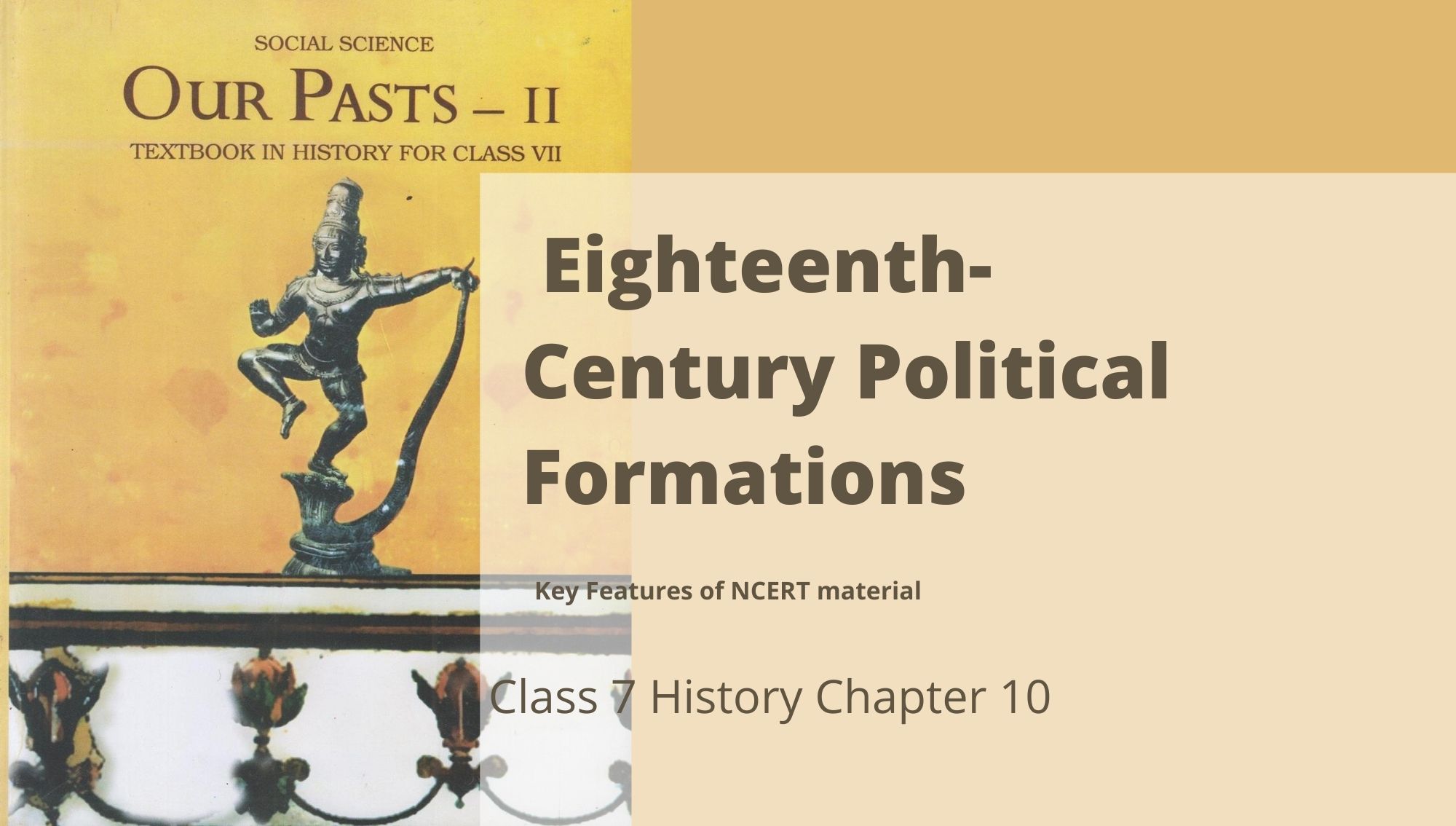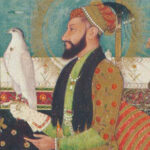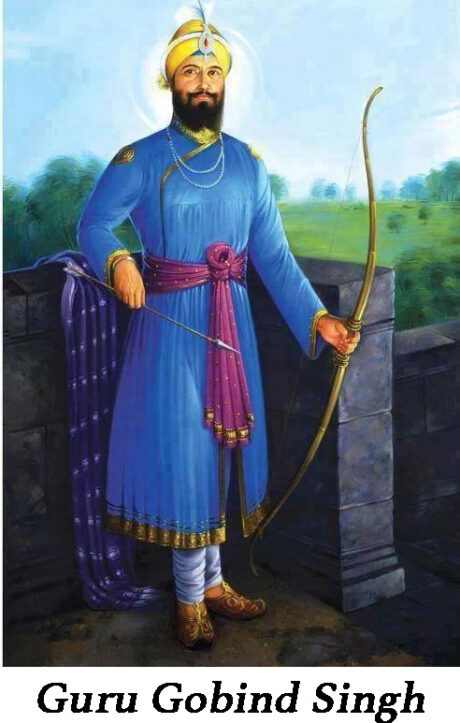Eighteenth-Century Political Formations: Class 7 History NCERT Chapter 10

Key Features of NCERT Material for Class 7 History Chapter 10 – Eighteenth-Century Political Formations
In the previous chapter 9 of NCERT class 7 history: The Making Of Regional Cultures, You studied how the regional cultures developed over the years. You also learnt how the regional cultures today are the result of complex processes of mixing of local traditions with ideas from different regions. In this chapter: Eighteenth-Century Political Formations, You will study the emergence of new political groups in the Indian subcontinent during the first half of the eighteenth century, after the death of Aurangzeb. You will also get to know about the third battle of Panipat fought in 1761.
Quick revision notes
By 1765, the British had conquered significant parts of Indian region in eastern India. After Aurangzeb’s passing, the Mughal Empire began to decline on account due to inefficient and weak rulers. States like Hyderabad, Awadh, Bengal and states heavily influenced by Sikhs and Marathas declared Independence. The decreasing power of the Mughals likewise gave rise to the regional powers like the Jats, Marathas and Sikhs.
The Empire crisis and the Later Mughals
- After arriving at its pinnacle, the Mughal empire began declining under Emperor Aurangzeb. This was a result of Aurangzeb’s military and religious policy which drained the financial resources of the Mughals.
- Under his rule, the efficiency of the imperial administration declined. It got difficult to check governors and mansabdars.
- Amidst this crisis, Nadir Shah’s attack in 1739 and attacks of Afghan ruler Ahmed Shah Abdali between 1748-1761, weakened the Mughal empire.
- The nobility was separated into two significant groups Iranis and Turanis. For quite a while, the later Mughal emperors were puppets in control of either of these two powerful groups.
The emergence of New States
- With the decrease of Mughal authority, the governors consolidated their power.
- Comprehensively, the states were partitioned into three overlapping groups; old Mughal areas like Awadh, Bengal and the Hyderabad States which appreciated independence like Watan Jagirs and many Rajput provinces and the last group included regions like Marathas, Sikhs and the Jats.
The Old Mughal Provinces
- These incorporated the states of Awadh, Bengal and Hyderabad.
- Hyderabad state was established by Nizam-ul-Mulk Asaf Jah. The state was constantly engaged in a battle against the Marathas.
- Awadh was established by Burhan-ul-Mulk Saadat Khan in 1722.
- The rich alluvial plains allowed the advancement of the region.
- Bengal was established by Murshid Quli Khan. He held power over the revenue administration of the state. Under Alivardi Khan the state got prosperous.
The Watan Jagirs of the Rajputs
- Numerous Rajput Kings, especially from Amber and Jodhpur had served under the Mughals with distinction.
- They got significant autonomy and hence were called Watan jagir.
- Maratha expansion after the 1740s put a limitation on the growth of Rajput expansion.
Seizing Independence
The Sikhs
- The Sikh emerged as a force under Guru Gobind Singh who inspired the Khalsa with the belief that their fate was to rule.
- Maharaja Ranjit Singh reunited the Sikhs as a powerful group and set up his capital at Lahore in 1799.
The Marathas
- The Maratha kingdom prospered under Shivaji. After Shivaji’s demise, Peshwa led the Maratha empire to its peak.
- Marathas gathered tremendous income from taxes of church and Sardshmukhi in the entire kingdom.
- Maratha chiefs were Peshwa, Sindhia, Gaekwad and Bhonsle. Their territory reached close to Delhi in its peak stages.
The Jats
- Jats were powerful in territories close to Delhi under the leadership of Churaman.
- They flourished as agriculturalists.
- Under Suraj Mai, the kingdom of Bharatpur emerged as a solid-state.
- Jats even constructed a garden place at Dig.
With the decrease of the Mughal Empire, new political groups started to emerge in the sub-continent during the first half of the eighteenth century.
The Mughal Empire lost its greatness and began confronting an assortment of emergencies towards the end long periods of the seventeenth century.
Emperor Aurangzeb is considered liable for this. He had drained the military and financial assets of his empire by battling a long war in the Deccan.
Under his successors, the proficiency of the imperial association declined. Nobles designated as governors turned out to be more powerful. They started to control the offices of revenue and military administration. This gave rise to a political and financial crisis.
The attack of Nadir Shah, the leader of Iran, on Delhi in 1739 aggravated the emergency. He looted the city of Delhi and took huge amounts of wealth.
And soon Ahmad Shah Abdali became active. He attacked north India five times between 1748 and 1761.
The competition among various groups of nobles further decreased the power of the empire. These were two significant groups—the Iranis and Taranis (nobles of Turkish descent). For quite a while, the later Mughal emperors were puppets in control of either of these two powerful factions.
Through the eighteenth century, the Mughal Empire slowly divided into various independent, regional states. The states of the eighteenth century can be fragmented into three overlapping groups.
States that were old Mughal regions, like Bengal, Awadh and Hyderabad. However, States which enjoyed independence under Mughals as Watan Jagirs. States controlled by Marathas, Sikhs and others like the Jats.
Hyderabad state (1724-1748) was established by Nizam-ul-Mulk Asaf Jah. He was one of the most powerful individuals at the court of the Mughal Emperor Farrukh Siyar. He was awarded the change of the Deccan. Before he became powerful there and pronounced himself the real ruler of that region. In spite of the fact that he was as yet a worker of the Mughal ruler, he ruled independently.
The territory of Awadh was established by Burhan-ul-Mulk Sa’adat Khan in the year 1722. He didn’t like the Mughal impact in the Awadh region and so decreased the number of officeholders or jagirdars appointed by the Mughals. He additionally decreased the size of jagirs and named his own loyal workers to vacant positions.
Murshid Quli Khan took control of Bengal and started to rule the revenue administration of the state. He moved all Mughal jagirdars to Orissa so as to decrease the Mughal impact in Bengal. He ordered a significant reassessment of the revenues of Bengal. Revenue was gathered in cash with strictness from all zamindars.
Rajputs
The Rajput Kings, of Amber and Jodhpur, were given authorization by the Mughals, to enjoy considerable independent rule in their water jagirs. Soon, these rulers started to broaden their authority over neighbouring regions.
Gujarat was governed by Raja Ajit Singh of Jodhpur. Sawai Raja Jai Singh of Amber was governor of Malva. They also attempted to expand their regions by seizing parts of imperial territories neighbouring their watans. Nagpur was conquered and added to the houses of Jodhpur while Amber seized onto huge parts of Bundi.
In the eighteenth century, the Sikhs assembled themselves into various groups called jathas and later on mils. Their joined forces were known as the grand armed force (dal Khalsa).
Guru Gobind Singh:
He had inspired the Khalsa with the conviction that their fate was to rule. Their well-knit association empowered them to set up effective resistance to the Mughal governors first and afterwards to Ahmad Shah Abdali who had seized onto the rich area of Punjab and the Sirhind from the Mughals. The Khalsa announced their sovereign rule by striking in 1765.
The Sikh territories stretched out from the Indus to the Jamuna in the late eighteenth century yet they were divided under various rulers like Maharaja Ranjit Singh.
Shivaji empowered the Maratha Kingdom. He built a powerful Maratha armed force and challenged the Mughals in the peninsula.
After the passing of Shivaji, Peshwas ruled the Maratha Kingdom. Poona turned into its capital.
Between 1720 and 1761, the Maratha empire extended and slowly removed the authority of the Mughal Empire. By the 1720s, Gujarat and Malwa were seized from the Mughals. Maratha King was perceived as the overlord of the whole Deccan peninsula by the 1730s.
In 1737 subsequent to raiding Delhi, the frontiers ruled by Maratha extended quickly into Rajasthan and Punjab in the north, into Bengal and Orissa in the east and into Karnataka and the Tamil and Telugu nations in the south.
The jats merged their power during the late seventeenth and eighteenth centuries. Under their leader, Churaman, they acquired power over territories towards the west of the city of Delhi, and by the 1680s they had started dominating the area between the two imperial cities of Delhi and Agra.
Subadar:
Government of a state or province.
Diwani:
The revenue offices.
Faujdari:
The administration of the military.
The Iranis and Taranis:
Turkish nobles.
Coffers:
Treasury.
Nayaks:
Telugu warrior heads.
Jagirdari:
Ownership of lands.
Ijaradars:
Revenue farmers.
Watan Jagirs:
States that enjoyed considerable autonomy under the Mughals. Jathas. Bands
Misls:
political groups of Sikh warriors.
Peshwa:
Chief minister.
Chauth:
The part (25%) of revenue claimed by zamindars.
Sardishmukhi:
Between 9-10% of the land revenue paid to the head revenue collector in the Deccan. Subahdar Governorship of a state or province.
Later Mughals:
The Mughal emperors who ruled after Aurangzeb.
Kunbis:
Peasant-warriors of Maratha region.
1707 – Aurangzeb passed away.
1739 – Delhi invasion by Nadir Shah.
1713-1719 – Farrukh Siyar ruled the Mughal Empire.
1754-1759 – Alamgir 11 ruled the Mughal Empire.
1724-1748 – Asaf Jah continued to be the Nizam of Hyderabad.
1722 – Burhan-ul-Mulk Sa’adat Khan was named Subadar of Awadh.
1699 – Khalsa was instituted in this year.
1708 – Guru Gobind Singh passed away.
1715 – Banda Bahadur was conquered
1716 – Execution of Banda Bahadur.
1799 – Maharaja Ranjit Singh built his capital at Lahore.
1627-1680 – Shivaji’s period.
1761 – The third battle of Panipat.



